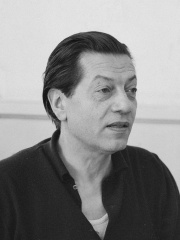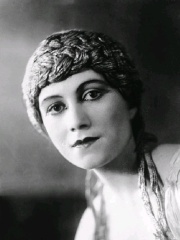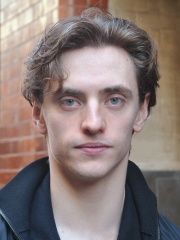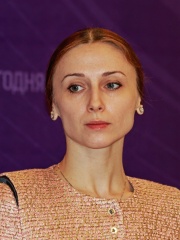






The Most Famous
DANCERS from Ukraine
Top 8
The following people are considered by Pantheon to be the most legendary Ukrainian Dancers of all time. This list of famous Ukrainian Dancers is sorted by HPI (Historical Popularity Index), a metric that aggregates information on a biography's online popularity.

1. Vaslav Nijinsky (1889 - 1950)
With an HPI of 75.42, Vaslav Nijinsky is the most famous Ukrainian Dancer. His biography has been translated into 54 different languages on wikipedia.
Vaslav or Vatslav Nijinsky (12 March 1889/1890 – 8 April 1950) was a Russian ballet dancer and choreographer of Polish ancestry. He is regarded as the greatest male dancer of the early 20th century. He is often associated with the Ballets Russes and its impresario Sergei Diaghilev, for which he choreographed such influential ballets as L'après-midi d'un faune (1912), Le Sacre du Printemps (1913), Jeux (1913), and Till Eulenspiegel (1916). He was celebrated for his virtuosity and for the depth and intensity of his characterizations. He could dance en pointe, a rare skill among male dancers at the time, and was admired for his seemingly gravity-defying leaps.

2. Serge Lifar (1904 - 1986)
With an HPI of 67.04, Serge Lifar is the 2nd most famous Ukrainian Dancer. His biography has been translated into 30 different languages.
Serge Lifar (Ukrainian: Сергій Михайлович Лифар, romanized: Serhii Mykhailovych Lyfar; 20 March [O.S. 2 April] 1905 – 15 December 1986) was a Ukrainian dancer. Lifar was also a choreographer, director, writer, theoretician about dance, and collector. As ballet master of the Paris Opera from 1930 to 1944, and from 1947 to 1958, he devoted himself to the restoration of the technical level of the Paris Opera Ballet, returning it to its place as one of the best companies in the world.

3. Olga Khokhlova (1891 - 1955)
With an HPI of 64.92, Olga Khokhlova is the 3rd most famous Ukrainian Dancer. Her biography has been translated into 24 different languages.
Olga Picasso (born Olga Stepanovna Khokhlova; Russian: Ольга Степановна Хохлова; 17 June 1891 – 11 February 1955) was a Russian ballet dancer in the Ballets Russes, directed by Sergei Diaghilev and based in Paris. There she met and married the artist Pablo Picasso, served as one of his early muses, and was the mother of their son, Paul (Paulo).

4. Natalia Dudinskaya (1912 - 2003)
With an HPI of 54.92, Natalia Dudinskaya is the 4th most famous Ukrainian Dancer. Her biography has been translated into 15 different languages.
Natalia Mikhailovna Dudinskaya (21 August [O.S. 8 August] 1912 – 29 January 2003) was a Soviet prima ballerina who dominated the Kirov Ballet from the 1930s to the 1950s. Four Stalin Prizes second degree (1941, 1947, 1949, 1951).

5. Svetlana Zakharova (b. 1979)
With an HPI of 52.51, Svetlana Zakharova is the 5th most famous Ukrainian Dancer. Her biography has been translated into 31 different languages.
Svetlana Yuryevna Zakharova (Ukrainian: Світлана Юріївна Захарова, Russian: Светлана Юрьевна Захарова; born 10 June 1979) is a Ukrainian-born prima ballerina who dances with the Bolshoi Ballet and is acting rector of the Moscow State Academy of Choreography.

6. Sergei Polunin (b. 1989)
With an HPI of 45.87, Sergei Polunin is the 6th most famous Ukrainian Dancer. Her biography has been translated into 22 different languages.
Sergei Vladimirovich Polunin (Russian: Сергей Владимирович Полунин; Ukrainian: Сергій Володимирович Полунін, romanized: Serhiy Volodymyrovych Polunin; born 20 November 1989) is a Russian ballet dancer, actor and model. He has Russian and Serbian citizenships, and has "always regarded himself as Russian". In 2025, he was stripped of his Ukrainian citizenship. Born in Kherson, Ukrainian SSR, Polunin started out in gymnastics before switching to ballet at the age of eight and attended the Kyiv State Choreographic College. After graduating, he joined the British Royal Ballet School at the age of 13 in 2003. Polunin has received numerous awards, including the Prix de Lausanne and Youth America Grand Prix in 2006, and in 2007 was named the Young British Dancer of the Year. In 2010, at the age of 20, Polunin became the Royal Ballet's youngest ever male principal dancer. After two years, he quit the ballet company to focus on a freelance career. As a freelance principal dancer, Polunin has been a guest artist at various theatres worldwide, such as Royal Opera House, Sadler's Wells Theatre, Bolshoi Theatre, Stanislavski and Nemirovich-Danchenko Moscow Academic Music Theatre, La Scala Theatre, Teatro San Carlo and was a guest artist for the Bayerisches Staatsballet.

7. Artem Datsyshyn (1979 - 2022)
With an HPI of 37.95, Artem Datsyshyn is the 7th most famous Ukrainian Dancer. His biography has been translated into 15 different languages.
Artem Viktorovych Datsyshyn (Ukrainian: Артем Вікторович Дацишин, 26 January 1979 – 17 March 2022) was a Ukrainian ballet dancer and soloist with the National Opera of Ukraine, where he performed leading roles in ballets including Tchaikovsky's Swan Lake and Prokofiev's Romeo and Juliet. He achieved prizes in international competitions, and toured in Europe, North America, and Japan. He was killed by Russian artillery fire during the 2022 Russian invasion of Ukraine.

8. Masha Dashkina Maddux (b. 1986)
With an HPI of 32.23, Masha Dashkina Maddux is the 8th most famous Ukrainian Dancer. Her biography has been translated into 15 different languages.
Mariya "Masha" Dashkina Maddux is a Ukrainian modern dancer and dance teacher. She is a former principal dancer with the Martha Graham Dance Company and is the founder and director of the Wake Forest Dance Festival.
People
Pantheon has 8 people classified as Ukrainian dancers born between 1889 and 1989. Of these 8, 3 (37.50%) of them are still alive today. The most famous living Ukrainian dancers include Svetlana Zakharova, Sergei Polunin, and Masha Dashkina Maddux. The most famous deceased Ukrainian dancers include Vaslav Nijinsky, Serge Lifar, and Olga Khokhlova. As of April 2024, 1 new Ukrainian dancers have been added to Pantheon including Artem Datsyshyn.
Living Ukrainian Dancers
Go to all RankingsSvetlana Zakharova
1979 - Present
HPI: 52.51
Sergei Polunin
1989 - Present
HPI: 45.87
Masha Dashkina Maddux
1986 - Present
HPI: 32.23
Deceased Ukrainian Dancers
Go to all RankingsVaslav Nijinsky
1889 - 1950
HPI: 75.42
Serge Lifar
1904 - 1986
HPI: 67.04
Olga Khokhlova
1891 - 1955
HPI: 64.92
Natalia Dudinskaya
1912 - 2003
HPI: 54.92
Artem Datsyshyn
1979 - 2022
HPI: 37.95
Newly Added Ukrainian Dancers (2025)
Go to all RankingsOverlapping Lives
Which Dancers were alive at the same time? This visualization shows the lifespans of the 5 most globally memorable Dancers since 1700.

